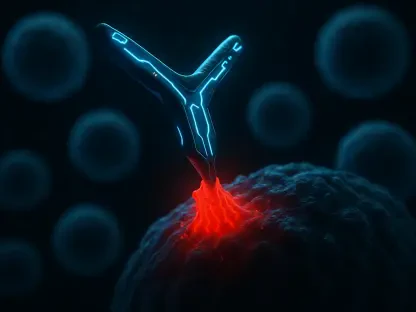Imagine a condition so rare yet so devastating that it drives an insatiable hunger, challenging both patients and medical science to find relief, while Prader-Willi syndrome, a genetic disorder affecting a small but deeply impacted population, has long awaited effective treatments for its hallmark symptom, hyperphagia. Acadia Pharmaceuticals’ recent decision to discontinue ACP-101, a potential therapy for this condition, after a failed Phase 3 trial has sparked widespread discussion in the pharmaceutical and rare disease communities. This roundup gathers diverse perspectives from industry analysts, market observers, and rare disease advocates to unpack why this promising drug fell short and what it means for future innovation in this space. The aim is to provide a comprehensive view of the challenges, opinions, and potential paths forward following this significant setback.
Exploring the Backstory of ACP-101’s Discontinuation
The journey of ACP-101 began with high hopes as Acadia Pharmaceuticals sought to address the unmet needs of Prader-Willi syndrome patients struggling with uncontrollable hunger. After acquiring the drug through the purchase of Levo Therapeutics a few years ago, Acadia pushed forward with a new Phase 3 trial involving 175 patients over 12 weeks. However, the recent announcement of its termination due to lackluster results—no significant improvement in hunger scores compared to placebo—has left stakeholders reevaluating the project’s viability. Industry watchers note that this failure not only impacts Acadia’s portfolio but also highlights the persistent difficulties in tackling rare disorders.
Beyond the specifics of the drug itself, the broader context of Prader-Willi syndrome underscores why this development was under such close scrutiny. With limited therapeutic options available, each attempt to innovate carries immense weight for patients and families. Advocacy groups emphasize that hyperphagia isn’t just a symptom—it’s a daily battle that affects quality of life profoundly. The discontinuation of ACP-101, therefore, isn’t merely a corporate decision but a blow to a community desperate for solutions, prompting questions about what went wrong and whether other approaches might succeed.
This discussion will delve into varied opinions on the trial’s shortcomings, the competitive landscape in Prader-Willi treatments, and the implications for Acadia’s strategy in rare disease research. Some industry voices see this as a predictable outcome given past hurdles, while others argue it reflects systemic challenges in drug development for niche conditions. By compiling these perspectives, a clearer picture emerges of both the specific missteps and the larger barriers at play.
Analyzing Factors Behind ACP-101’s Failure
Unpacking the Phase 3 Trial Setbacks
The Phase 3 trial for ACP-101 aimed to measure improvements in hunger through a specialized questionnaire but ultimately showed no meaningful difference between the drug and a placebo across primary and secondary endpoints. Industry analysts point out that this lack of efficacy raises questions about the drug’s mechanism and its ability to address hyperphagia effectively. Many suggest that the trial’s failure might not solely reflect on ACP-101’s potential but on the complexities of capturing subjective experiences like hunger in a clinical setting.
Further scrutiny reveals that designing trials for such unique symptoms presents inherent difficulties. Some experts in clinical research argue that patient selection criteria might have influenced the results, potentially including individuals whose hunger profiles were less responsive to the drug’s intended action. Others highlight that the 12-week duration may have been insufficient to detect gradual changes, suggesting that longer observation periods could be necessary for future studies in this field.
A contrasting view from trial methodology specialists focuses on the tools used to assess outcomes. They note that questionnaires, while valuable, can introduce variability due to patient or caregiver interpretation. This perspective calls for innovative assessment methods, possibly integrating digital health tools or biomarkers, to provide more objective data in subsequent research efforts for Prader-Willi syndrome therapies.
Tracing the Legacy of Carbetocin and Acquisition Challenges
ACP-101, a reformulated version of carbetocin, came into Acadia’s hands through the acquisition of Levo Therapeutics, a company that previously failed to secure FDA approval for an intranasal form of the same compound. Market observers have long viewed this move as a gamble, with some describing it as a low-cost but high-risk strategy. The historical regulatory struggles of carbetocin cast a shadow over ACP-101 from the start, leading many to question whether Acadia overestimated the drug’s potential for success.
Delving deeper, financial analysts argue that the acquisition reflected a broader trend of companies taking on distressed assets in hopes of turning them around with fresh resources or trial designs. However, they caution that such strategies often underestimate the entrenched challenges tied to a drug’s past failures. In this case, the skepticism surrounding carbetocin’s efficacy and safety profile likely influenced investor confidence even before the latest trial results were announced.
On the other hand, some industry strategists defend Acadia’s decision to pursue ACP-101, suggesting that rare disease markets offer high rewards for those willing to navigate uncertainty. They point out that while the outcome was disappointing, the attempt itself demonstrates a commitment to addressing underserved conditions. This view emphasizes learning from setbacks rather than avoiding risk altogether, urging companies to refine their due diligence processes for future acquisitions.
Navigating Competitive Pressures and Market Dynamics
The competitive landscape for Prader-Willi syndrome treatments shifted dramatically with Soleno Therapeutics’ FDA-approved Vykat XR, the first drug specifically targeting hyperphagia, launched earlier this year. Its strong sales performance has set a high benchmark, and market analysts note that Acadia’s stock dropped 11% following the ACP-101 announcement, while Soleno’s rose by 13%. This stark contrast illustrates how quickly market dominance can shift in niche therapeutic areas when a viable solution emerges.
However, not all views on Soleno’s success are uniformly positive. Some financial commentators highlight recent controversies, such as safety concerns raised by investment research firms, which have caused fluctuations in Soleno’s stock value. They argue that while Vykat XR currently leads, its long-term position could be vulnerable if safety issues persist, potentially opening doors for other players—though Acadia’s exit with ACP-101 leaves that opportunity uncertain for now.
A differing perspective from rare disease market specialists suggests that Acadia may have misjudged the speed at which competitors could capture the market. They propose that the focus on ACP-101 might have diverted resources from exploring alternative mechanisms or partnerships that could have positioned Acadia more favorably against Vykat XR. This opinion underscores the need for agility in strategic planning within highly competitive, small-market segments.
Reflecting on Broader Implications for Rare Disease Innovation
Developing drugs for rare conditions like Prader-Willi syndrome involves navigating a landscape of high stakes and frequent disappointments, a reality echoed by many in the pharmaceutical sector. The small patient populations limit trial scalability, while the profound needs demand innovative solutions, often leading to a high rate of trial failures. Industry leaders stress that setbacks like ACP-101 are not anomalies but part of the iterative process of advancing science for niche disorders.
Regulatory perspectives add another layer to this discussion, with some policy analysts noting that evolving expectations from agencies like the FDA can complicate development timelines. They argue that balancing rigorous safety standards with the urgent needs of rare disease communities requires ongoing dialogue between regulators and developers. This view advocates for adaptive trial designs or accelerated pathways to mitigate some of the risks inherent in these projects.
Patient advocacy groups offer a more hopeful take, suggesting that each failure provides critical data to refine future approaches. They emphasize that while ACP-101 did not succeed, the attention it brought to hyperphagia has heightened awareness and could spur funding or interest in alternative therapies. This optimistic stance encourages viewing such outcomes as stepping stones rather than dead ends, pushing for sustained commitment to rare disease research.
Key Takeaways and Strategic Directions for Acadia
Synthesizing the insights gathered, the termination of ACP-101 stems from a combination of trial inefficacy, a challenging history tied to its acquisition, and an increasingly competitive market dominated by Soleno’s Vykat XR. Industry analysts largely agree that the lack of improvement in hunger scores was a decisive blow, compounded by lingering doubts about the drug’s origins as a reformulated carbetocin with prior regulatory setbacks. These factors collectively eroded confidence in the project’s potential.
Looking at strategic pivots, many market observers recommend that Acadia redirect focus toward other pipeline assets with stronger preliminary data, such as an experimental treatment for Alzheimer’s disease psychosis. This shift could help restore investor trust by demonstrating a diversified approach to innovation. Additionally, some suggest exploring collaborative efforts or licensing opportunities to bolster resources for tackling rare disease challenges more effectively.
From a stakeholder engagement standpoint, transparency emerges as a key theme across opinions. Financial advisors urge Acadia to communicate openly about lessons learned from ACP-101 and outline clear next steps for their research portfolio. Building a narrative of resilience and adaptability, according to these views, is essential to maintaining credibility in a sector where setbacks are common but trust remains paramount.
Evolving Horizons in Prader-Willi Syndrome Treatments
The halt of ACP-101 has sparked intense debate about the specific reasons behind its failure and the broader hurdles in rare disease drug development. Diverse opinions have converged on the notion that while Acadia faced a significant loss, the landscape for Prader-Willi syndrome treatments remains dynamic, with Soleno’s success highlighting the potential for impactful innovation despite its own challenges. This moment has served as a reminder of the delicate balance between risk and reward in pharmaceutical advancements.
Moving forward, stakeholders should consider prioritizing investment in novel mechanisms and trial methodologies that address the unique aspects of hyperphagia and similar symptoms. Exploring partnerships with technology firms to integrate objective measurement tools could enhance future studies. Additionally, continued advocacy for regulatory flexibility in rare disease contexts might pave the way for more tailored development pathways, ensuring that patient needs drive scientific progress in meaningful ways.









